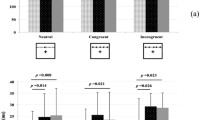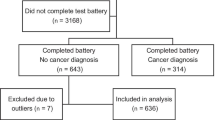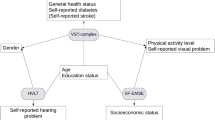Abstract
Several studies, showing that attention disorders during encoding reduce later memory performance, have stressed the critical role of attention for the formation of durable memory traces. Accordingly, some studies suggest that attentive disturbances, together with declarative memory defects, can constitute the earliest cognitive disorders in Alzheimer’s disease. Therefore, the analysis of these disorders can contribute to identify different forms of dementia and to detect demented patients characterized by a faster cognitive decline. In this study, we report the normative data (gathered in a large Italian population) of a short test that assess the ability to detect stimuli characterized by a conjunction of features: the ‘Multiple Features Targets Cancellation’ task (MFTC). Our sample of 465 subjects was composed by urban and rural people. Multiple linear regression analyses revealed significant relation of false alarms with age and educational level, and of time of execution with age, educational level and gender. Regression analyses on accuracy scores did not show any significant correlation with demographics variables. Based on non-parametric techniques, cutoff scores were obtained on the corrected scores of the patients, and equivalent scores were derived for each measure. The MFTC task represents a useful tool that explores attentional disorders (and in particular conjunction search disturbances) and that could be helpful both in discriminating different forms of dementia and to detect mild cognitive impairment patients at risk of conversion to dementia.
Similar content being viewed by others
References
Perry RJ, Hodges JR (1999) Attention and executive deficits in Alzheimer’s disease. A critical review. Brain 122(Pt 3):383–404
Porter G, Tales A, Troscianko T, Wilcock G, Haworth J, Leonards U (2010) New insights into feature and conjunction search: I. Evidence from pupil size, eye movements and ageing. Cortex 46(5):621–636
Tales A, Haworth J, Nelson S, Snowden RJ, Wilcock G (2005) Abnormal visual search in mild cognitive impairment and Alzheimer’s disease. Neurocase 11(1):80–84
Camicioli R, Howieson D, Lehman S, Kaye J (1997) Talking while walking: the effect of a dual task in aging and Alzheimer’s disease. Neurology 48(4):955–958
Perry RJ, Zeki S (2000) The neurology of saccades and covert shifts in spatial attention: an event-related fMRI study. Brain 123(Pt 11):2273–2288
Davis ET, Palmer J (2004) Visual search and attention: an overview. Spat Vis 17(4–5):249–255
Tales A, Butler SR, Fossey J, Gilchrist ID, Jones RW, Troscianko T (2002) Visual search in Alzheimer’s disease: a deficiency in processing conjunctions of features. Neuropsychologia 40(12):1849–1857
Porter G, Leonards U, Wilcock G, Haworth J, Troscianko T, Tales A (2010) New insights into feature and conjunction search: II. Evidence from Alzheimer’s disease. Cortex 46(5):637–649
Foldi NS, Schaefer LA, White RE, Johnson R Jr, Berger JT, Carney MT, Macina LO (2005) Effects of graded levels of physical similarity and density on visual selective attention in patients with Alzheimer’s disease. Neuropsychology 19(1):5–17
Sebastian MV, Menor J, Elosua MR (2006) Attentional dysfunction of the central executive in AD: evidence from dual task and perseveration errors. Cortex 42(7):1015–1020
Gainotti G, Marra C, Villa G (2001) A double dissociation between accuracy and time of execution on attentional tasks in Alzheimer’s disease and multi-infarct dementia. Brain 124(Pt 4):731–738
Tabert MH, Manly JJ, Liu X, Pelton GH, Rosenblum S, Jacobs M, Zamora D, Goodkind M, Bell K, Stern Y, Devanand DP (2006) Neuropsychological prediction of conversion to Alzheimer disease in patients with mild cognitive impairment. Arch Gen Psychiatry 63(8):916–924
Buccione I, Perri R, Carlesimo GA, Fadda L, Serra L, Scalmana S, Caltagirone C (2007) Cognitive and behavioural predictors of progression rates in Alzheimer’s disease. Eur J Neurol 14(4):440–446
Fleisher AS, Sowell BB, Taylor C, Gamst AC, Petersen RC, Thal LJ (2007) Clinical predictors of progression to Alzheimer disease in amnestic mild cognitive impairment. Neurology 68(19):1588–1595
Palmer K, Lupo F, Perri R, Salamone G, Fadda L, Caltagirone C, Musicco M, Cravello L (2011) Predicting disease progression in Alzheimer’s disease: the role of neuropsychiatric syndromes on functional and cognitive decline. J Alzheimers Dis 24(1):35–45
Marra C, Silveri MC, Gainotti G (2000) Predictors of cognitive decline in the early stage of probable Alzheimer’s disease. Dement Geriatr Cogn Disord 11(4):212–218
Measso G, Caverzan F, Lebowitz BD, Crooke TH, Pirozzolo FJ, Amaducci LA, Massari D, Grigoletto F (1993) The mini-mental state examination. Normative study of an Italian random sample. Dev Neuropshychol 9:77–85
Spinnler H, Tognoni G (1987) Standardizzazione e taratura di test neuropsicologici. Ital J Neurol Sci 8(Suppl 6):1–120
Rizzo M, Anderson SW, Dawson J, Myers R, Ball K (2000) Visual attention impairments in Alzheimer’s disease. Neurology 54(10):1954–1959
Madden DJ, Whiting WL, Cabeza R, Huettel SA (2004) Age-related preservation of top-down attentional guidance during visual search. Psychol Aging 19(2):304–309
Solbakk AK, Fuhrmann Alpert G, Furst AJ, Hale LA, Oga T, Chetty S, Pickard N, Knight RT (2008) Altered prefrontal function with aging: insights into age-associated performance decline. Brain Res 1232:30–47
Gomez-Perez E, Ostrosky-Solis F (2006) Attention and memory evaluation across the life span: heterogeneous effects of age and education. J Clin Exp Neuropsychol 28(4):477–494
Cerella J (1985) Information processing rates in the elderly. Psychol Bull 98(1):67–83
Salthouse TA (1996) The processing-speed theory of adult age differences in cognition. Psychol Rev 103(3):403–428
Rush MC, Panek PE, Russell JE (1987) Cautiousness and visual selective attention performance among older adults. J Genet Psychol 148(2):225–235
Watson DG, Maylor EA, Bruce LA (2005) Search, enumeration, and aging: eye movement requirements cause age-equivalent performance in enumeration but not in search tasks. Psychol Aging 20(2):226–240
Whiting WL, Madden DJ, Pierce TW, Allen PA (2005) Searching from the top down: ageing and attentional guidance during singleton detection. Q J Exp Psychol A 58(1):72–97
Bell EC, Willson MC, Wilman AH, Dave S, Silverstone PH (2006) Males and females differ in brain activation during cognitive tasks. Neuroimage 30(2):529–538
Rubia K, Hyde Z, Halari R, Giampietro V, Smith A (2010) Effects of age and sex on developmental neural networks of visual-spatial attention allocation. Neuroimage 51(2):817–827
Author information
Authors and Affiliations
Corresponding author
Appendix
Appendix

Rights and permissions
About this article
Cite this article
Marra, C., Gainotti, G., Scaricamazza, E. et al. The Multiple Features Target Cancellation (MFTC): an attentional visual conjunction search test. Normative values for the Italian population. Neurol Sci 34, 173–180 (2013). https://doi.org/10.1007/s10072-012-0975-3
Received:
Accepted:
Published:
Issue Date:
DOI: https://doi.org/10.1007/s10072-012-0975-3




